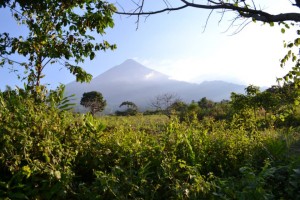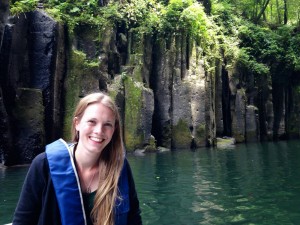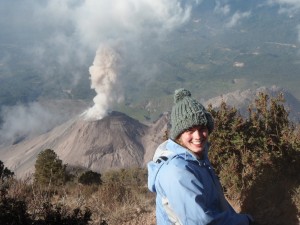A significant way that geologists contribute to international development is through their work on natural hazards (e.g., earthquakes, landslides, volcanic eruptions) and subsequent contribution to disaster risk reduction (DRR). As such we’re delighted to welcome Clare Sweeney to our blog team – to write specifically about all things hazard and disaster. Clare is a recent graduate of Bristol University’s Masters Programme in Volcanology, including a field course in Guatemala. Here Clare introduces herself and this new DRR blog column…
This blog column will focus on one of the most exciting areas of geology, geohazards. I’ll be exploring disaster risk reduction (DRR) success stories, bringing you up to date on the latest from the upcoming Hyogo Framework for Action 2 (HFA2) discussions and subsequent outcomes, and looking at some of the world’s most amazing natural phenomena.
The World Bank is exploring the international understanding of risk and together with the United Nations (UN) they summarised what is so un-natural but important to recognise about natural hazard related disasters:

The volcano Fuego, taken from the Fuego Volcano Observatory in Guatemala. It is a remarkable natural feature, but also a very real danger to the many communities living and working around the slopes. (Credit: Clare Sweeney)
“Earthquakes, droughts, floods and storms are natural hazards, but unnatural disasters are deaths and damages that result from human acts of omission and commission. Every disaster is unique, but each exposes actions- by individuals and governments at different levels- that, had they been different, would have resulted in fewer deaths and less damage.” (Natural Hazards, UnNatural Disasters)
While we can’t control nature, we can take responsibility for protecting ourselves and our homes from how it will affect us. We need to support community-based resilience, and we need governments to commit to protecting citizens and help them get back to their feet after the worst has happened. It’s very important for us as geologists to understand the differences between disaster and hazard, and how our work can support the Hyogo Framework for Action (HFA) and its soon-to-be-published successor. The HFA, put simply, is a strategic set of goals and actions set up in 2005 with three main aims:
- Incorporate DRR into sustainable development,
- Strengthen institutions against losses from hazards,
- Incorporate of risk reduction approaches into the implementation of emergency preparedness, response and recovery programmes
This month as the HFA is being reviewed at the 3rd United Nations World Conference on DRR (WCDRR) in Sendai, Japan, it gives us another chance to assess how we as the geoscience community can be involved in this important work.
Follow us and share your thoughts as the next move unfolds!
About Me
After completing a BSc Geology at the University of Durham I went on to study for a MSc in Volcanology at the University of Bristol. During the Masters I was lucky enough to travel to Guatemala to look at the impact of natural hazards within communities living in volcanically active areas. Following this I received a bursary to spend part of the year studying in Nagoya University, Japan. Both countries showed strengths in the development of DRR measures but with different approaches. Seeing an opportunity for stronger communication and the benefit of sharing experiences I am now actively pursuing opportunities to develop a career in disaster risk reduction.
Look out for more of Clare’s columns in the coming weeks and months. If you are a student or recent graduate with a strong interest in another area of geology and development (e.g., mining, water, engineering geology, climate) then please get in contact as we’d love to recruit other blog columnists.



Pingback: » What’s up? The Friday links (74)